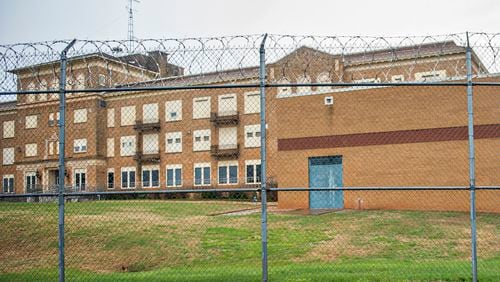While the growth in Georgia’s prison population has slowed after years of changes in the state’s criminal justice system, the inmate count is still expected to rise by more than 1,200 inmates in the next half-decade, according to a new state audit.
"Had we not been doing criminal justice reform, that 1,200 number would probably be 7,500 or so," said House Appropriations Chairman Terry England, R-Auburn, whose panel requested the audit.
But the report also raises a broader question about who should house those new inmates.
The audit says it costs the state more to house comparable inmates in private prisons than state facilities, which is contrary to long-held beliefs of lawmakers supportive of increased privatization of government.
The state already pays two private prison companies almost $140 million a year to house 15 percent of its inmate population. That’s about double what the state spent on private prisons 12 years ago.
The companies — Florida-based GEO Group and Nashville, Tenn.-based CoreCivic, formerly Corrections Corporation of America — are active political players at the Capitol. Their contributions to state candidates and political action committees during the most recent election cycle totaled more than $300,000, according to an Atlanta Journal-Constitution analysis of campaign finance records.
Like England, the companies have questions about the cost comparisons reached by state officials.
Georgia spends about $1.2 billion a year housing prisoners. In fiscal 2018, which ended June 30, the Georgia Department of Corrections averaged just over 50,000 inmates a day in prisons, including those in private facilities and county correctional institutions.
When Gov. Nathan Deal took office in 2011, Georgia led the nation in criminal supervision, with 1 in 13 people either locked up, on probation or on parole. The state was spending about what it is now on its prison system. If nothing changed, two new adult prisons would have had to have been built at a cost of $264 million.
Deal, with support from lawmakers, began a years-long effort to alter that trend, reducing certain nonviolent felonies to misdemeanor offenses. For example, lawmakers raised the threshold for felony shoplifting from $500 in stolen merchandise to $1,500. They also created new categories of punishment for drug possession, with less severe penalties for offenders found with small quantities.
The changes diverted hundreds of nonviolent offenders away from prison, where it costs about $20,000 a year to house an inmate.
The governor also greatly expanded accountability courts in Georgia that take in drug addicts, the mentally ill, veterans and juveniles who've committed nonviolent offenses. A state study said that recidivism rates for graduates of accountability courts are about 10 to 15 percentage points lower than those of similarly situated defendants who did not participate.
England said his committee asked for the audit to see what impact the criminal justice changes had on long-term projections for Georgia’s prison population.
“We do stuff all the time and never really look at what the impact is,” England said.
The audit estimated an increase of 1,277 inmates over the next five years. The increase, auditors said, will result in more than 97.5 percent of standard prison beds being filled in most facilities. “For some offender populations, the utilization rates may come close to, or exceed, 100 percent,” the report said.
The corrections agency told auditors it will likely try to expand capacity in state facilities. Six facilities have been identified as potential expansion sites. In addition, private prison officials estimated they have 400 additional beds available for contract.
The cost of housing an offender averaged about $65.58 per day across all types of state prison facilities, including maximum and medical units.
But auditors said when controlling for an offender’s sex, facility size and risk classification, state prisons cost $44.56 per day, per similar offender, as opposed to $49.07 in private prisons. The four private prisons the state uses averaged about 7,800 inmates in medium-security facilities, according to the state.
England said it’s not clear to him whether the comparisons take into account the full cost for state facilities, such as pensions for the thousands of corrections officers who work for the Department of Corrections. He said he wants to dig into the numbers further before coming to any conclusion about whether it’s cheaper for the state to expand its facilities or spend more leasing beds from private facilities.
In a statement, the GEO Group said: “Over the past three years, we’ve invested additional financial resources to improve offender rehabilitation services and outcomes which are not included in our per diem rate, therefore, we believe our cost would be lower if the auditors had compared all of the services and programs we offer at the Riverbend Correctional Facility.
“We hope to have a meeting with the auditors sometime early next year to better understand their methodology and analysis and to provide them additional data for inclusion in future studies.”
Rodney E. King, public affairs manager at CoreCivic, said: “CoreCivic is grateful for our partnership with the Georgia Department of Corrections and is committed to meet and exceed their expectations. GDC’s contract with CoreCivic empowers the state with the flexibility to adjust inmate populations as needed and also provides the budgetary certitude of knowing the total costs of incarceration for a defined period of time.”
WHY IT MATTERS
Georgia has made a number of changes in its criminal justice system under Gov. Nathan Deal’s watch, keeping more nonviolent offenders out of prison and sparing the state the expense of housing them at an average cost of about $20,000 a year. A state audit, however, projects an increase of more than 1,200 inmates in Georgia’s prison system over the next half-decade, and it also raises questions about the costs of private and state prisons.
About the Author








